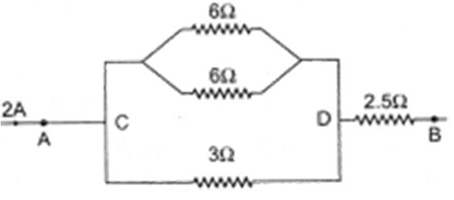 Multiple Choice Questions
Multiple Choice QuestionsTwo equal resistances R are joined with voltage source V in (i)series (ii)parallel, the ratio of electrical power consumed in two cases will be
1:4
4:1
2:1
1:2
When a resistance of α Ω is connected at the ends of a battery, its potential difference decreases from 40 V to 30V. The internal resistance of the battery is
3Ω
6Ω
1.5Ω
4Ω
The equivalent resistance and potential difference between A and B for the circuit
respectively are

4Ω, 8V
8Ω, 4V
2Ω, 2V
16Ω, 2V
A wire of resistance R is divided in equal parts, then these parts are joined in parallel, the equivalent resistance of the combination will be
nR
When a certain current is passed in the circuit as shown in figure, 10 kcal of heat is produced in 5 Ω resistance. How much heat is produced in 4 Ω resistance?

4 kcal
2 kcal
5 kcal
3 kcal
In the given circuit, what will be the equivalent resistance between the points A and B ?

10 / 3 Ω
20 / 3 Ω
10 / 5 Ω
5 Ω
A uniform wire of length I and having resistance R is cut into n equal parts and all parts are connected in parallel, then the equivalent resistance will be :
R
R/n
R/n2
n2R
C.
R/n2
Two or more resistors are said to be parallel if one end of all the resistors are joined together and simillarly the other ends are joined together.
Resistance of each part R' = R/n
When these parts are connected in parallel.
Then,
When a wire of uniform cross-section a, length land resistance R is bent into a complete circle, resistance between two of dimetrically opposite points will be
4R
